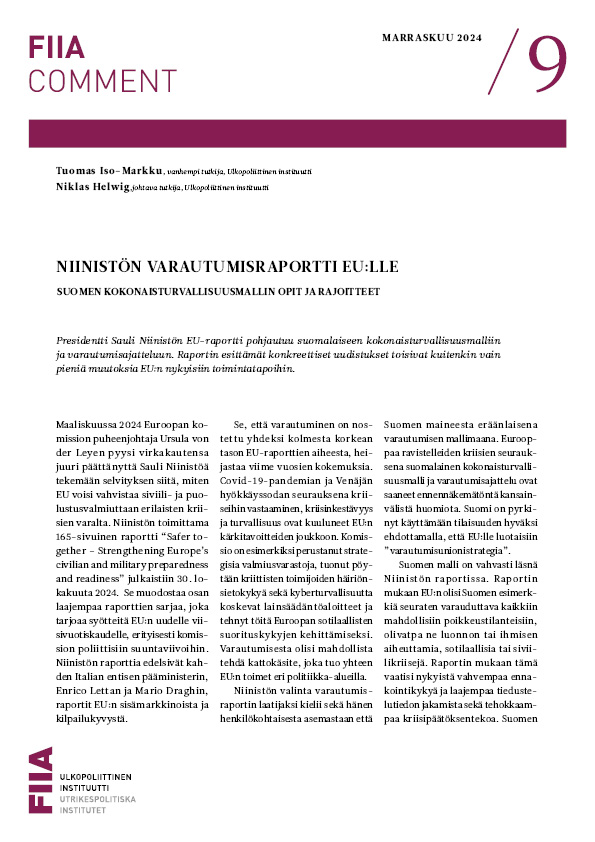Estonia will take over the presidency of the Council of the EU on 1 July. The rotating presidency has limited powers, but provides a good image-building opportunity. Estonia’s goal to distinguish itself from the Eastern member states, while supporting the EU’s unity, entails a difficult balancing act.
Estonia’s first-ever presidency coincides with turbulent times, starting six months earlier than planned with the Baltic state taking the UK’s slot because of Brexit. The mood in the European Union has brightened since the French presidential elections, and the prospect of major reforms in areas such as the Economic and Monetary Union (EMU) and defence cooperation looks more promising than in many previous years.
Yet divisions between and inside European countries caused by populist Eurosceptic forces and disagreements over handling migration make it hard to strengthen the Union while keeping all 27 member states on board with reforms. Estonia’s presidency motto, ‘Unity through balance’, is becoming increasingly difficult to maintain in a fragmenting Union.
For a small and peripheral country such as Estonia, unity is not just a slogan, but actually matters more than for many other member states. The positions of Poland and Hungary are particularly problematic for the EU and tricky for Estonia. The governments of these two countries are not just Eurosceptic; they are undermining core principles of the EU such as the rule of law and freedom of the media. Furthermore, their failure to show solidarity in the EU’s response to the migration crisis has contributed to making them outcasts in the eyes of many other member states. Their views are partly shared by the two other Visegrad countries, the Czech Republic and Slovakia.
These developments have given rise to a number of commentaries in the European public debate about the problems created by the ‘new Eastern member states’. The negative perception is often collectively stamped on all of the countries that joined the Union during the latest wave of enlargement.
Estonia has worked for years to shrug off the ‘Eastern’ label and to prove itself as a pro-European and constructive member of the Union. Twenty-five years after the collapse of the Soviet Union, and representing one of the most successful and rapid transformations, hardly anything is more irritating for many Estonians than still being referred to as a ‘post-Soviet’ country. Estonia has joined every possible form of deepening integration. According to the latest Eurobarometer survey, 67% of Estonians support EU membership, while the average across the EU is 57%. The country’s former and current presidents, Toomas Hendrik Ilves and Kersti Kaljulaid, are both vocal defenders of liberal values, sometimes at odds with more conservative and intolerant views among citizens.
In the migration crisis, Estonia (as well as Latvia and Lithuania) reluctantly accepted the relocation quotas, largely out of fear that any refusal to do so would have damaged their position in the Union. Estonia has its own populist Eurosceptic party with a strong anti-immigration agenda, the Conservative People’s Party of Estonia (EKRE), which is akin to the Finns Party in Finland or Law and Justice (PiS) in Poland. Its popularity has remained fairly low, between 6 and 14 per cent during the past couple of years, although the party has been in opposition.
A major priority of the presidency, digital Europe, will serve to highlight Estonia’s profile as a dynamic and IT-savvy Northern country. Estonia is aiming at the creation of a digital single market, with the free movement of data envisioned to become the fifth core freedom (in addition to the free movement of goods, capital, services and labour). Estonia’s activity in this field builds on its internationally acknowledged pioneering role in developing e-government. The other side of the coin is strong expertise in cyber security. Estonia prides itself on a high level of preparedness, which allowed it to avoid the recent global ransomware attacks that hit 150 countries and core public services such as hospitals in the UK in May. One of the presidency highlights will be a summit focusing on Europe’s digital future, to be held in Tallinn in late September.
Yet the presidency cannot avoid dealing with divisive issues. Estonia (like several other member states) has been conspicuously quiet about what the EU should do to counter the erosion of the rule of law in Poland and Hungary – and hence in parts of the EU. One of the explanations for this is concern about the regional security situation. Poland has been an important ally in working for a firm Western response to Russia’s aggression against Ukraine and destabilizing activities in the Baltic Sea region. In the words of Prime Minister Jüri Ratas, ‘The EU’s unity is our most important foreign policy tool’.
However, the question of how to put pressure on Poland and Hungary to respect the rule of law is gaining weight on the EU’s agenda. It is hard for Estonia to build a ‘non-Eastern’ profile while avoiding this issue.
The debate on future EU reforms, spearheaded by France and Germany, is also exposing divisions in the Union. Estonia is generally supportive of ongoing efforts to strengthen the EMU and defence cooperation; for example, the Baltic state wishes to be part of the planned ‘permanent structured cooperation’ in the field of defence. But Brussels, Berlin and Paris are gearing up for bigger changes, possibly through a treaty reform. This may lead to growing differentiation between the ‘core’ Europe, most likely consisting of the Eurozone countries, and the rest. The most vocal critics of such prospects are, once again, Poland and Hungary, which have not adopted the euro and are fearful of the weakening of their position. It is thus becoming increasingly difficult to strike a balance between reforming the EU and maintaining unity.









